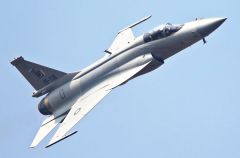Bulgaria is to be offered the Pakistan Aeronautical Complex/Chengdu Aircraft Industry Corporation (PAC/CAC) JF-17 Thunder combat aircraft, according to national media reports.
The single-seat, single-engined fighter is to be offered by Pakistan as an alternative to the several Western aircraft types that are all vying to be selected by Bulgaria as it looks to replace its ageing MiG-29 'Fulcrum' and Sukhoi Su-25 'Frogfoot' platforms, the novinite.com Sofia News Agency reported on 4 March.
No details pertaining to costs or potential delivery timelines were revealed.
The Bulgarian government has stated that it will choose to buy new or secondhand Western fighters, or commit to a further MiG-29 upgrade. The acquisition of 'new' fighters is expected to cost more than BGN500 million (USD282 million), although actual new aircraft, such as Lockheed Martin Block 52 F-16s, are almost certainly unaffordable.
Contenders for secondhand jets include surplus Block 25 F-16s from the US Air National Guard, F-16 midlife upgrade aircraft from Belgium, early tranche Eurofighter Typhoons from the Italian Air Force, or surplus Saab Gripens from Sweden.
Developed jointly by China (where it is designated the FC-1) and Pakistan, the JF-17 Thunder made its maiden flight in 2004. Powered by a single Russian-designed but Chinese-built Klimov RD-93 (RD-33 derivative) turbofan, it has a top speed of Mach 1.6 (at altitude); a radius-of-operation of 648 n miles (1,200 km) as a fighter and 378 n miles (700 km) as a ground attack platform; a range of 971 n miles (1,798 km) on internal fuel, or 1,100 n miles (2,037 km) for ferry; a service ceiling of 52,500 ft; and a g-rating of +8.5/-3.5.
It has seven underwing/fuselage hardpoints, and is equipped with an internal GSh-23-2 twin-barrel cannon. Weapon options include up to four PL-5, -7, -8 or -9 short-range air-to-air missiles (AAMs) or four PL-12/SD-10B medium-range AAMs; two C-802A anti-ship missiles; two anti-radiation missiles; five 500 kg bombs; twin launchers for up to eight 250 kg, MK-20, GBU-12 or anti-runway bombs; single 1,000 kg bomb or GBU-10; or up to three mission pods.
ANALYSIS
Although widely offered for export with countries such as Argentina, Serbia, and even Saudi Arabia, the JF-17 has yet to secure its first international customer.
While Bulgaria's economic situation would appear to make it a good candidate for the approximately USD30 million fighter (a comparable Western type would likely cost double this at least), its status as a NATO member would not.
As one of the alliance's newest members, Bulgaria is striving towards achieving full interoperability with its NATO partners, and indeed this is one of the primary reasons that it is looking to replace its Soviet-era MiGs and Sukhois. The JF-17 is not a NATO-compatible aircraft (although it can be upgraded to be so), and so is not a good fit for Bulgaria operationally.
Politically, such a procurement of a joint Chinese-Pakistani platform would be extremely difficult for Bulgaria, as evidenced by the reaction to Turkey's proposed procurement of the China Precision Machinery Import and Export Corp (CPMIEC) HQ-9 air and missile defence system in 2013.
That decision caused a fury, with Turkey's alliance partners saying that the Chinese system would never be integrated with NATO systems, effectively forcing a back down from the Turkish government, which is now moving away from the HQ-9 and is restarting negotiations with US and European suppliers instead.
Being a new and enthusiastic member of NATO, Bulgaria will be loath to place itself in a similar position, and for this reason primarily it would seem that a JF-17 buy is not likely to happen.


